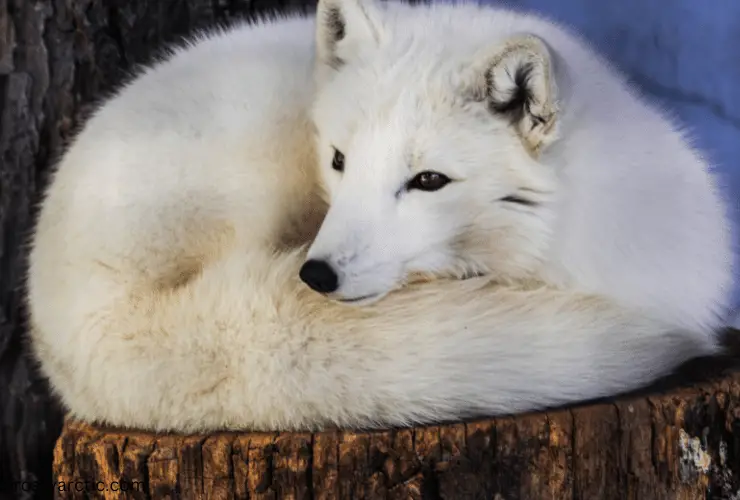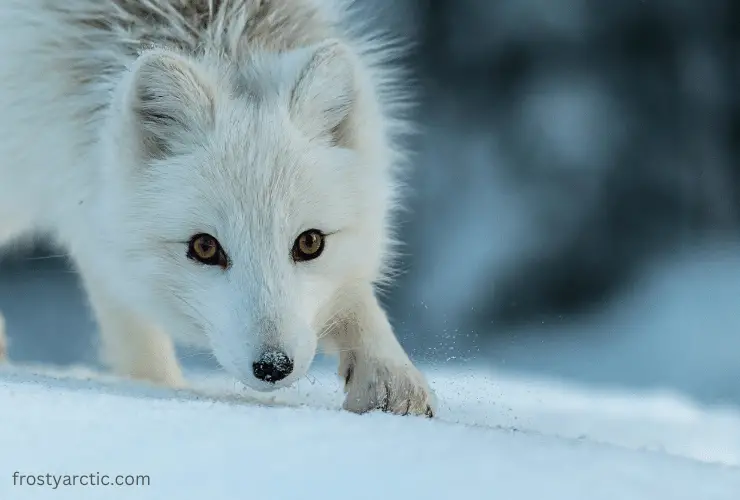According to Eva Fuglei (research biologist interested in terrestrial arctic ecosystems), one of the most characteristic creatures in Tundra is Arctic foxes (Vulpes Lagopus) (Source).
If you possess a deep affinity for knowing interesting facts about this arctic animal, then you are in the right place. So, what are the most interesting facts about Arctic foxes?
I have made a shortlist of the most interesting facts about Arctic foxes. Let’s enjoy the interesting discovery related to Arctic foxes.
- 8 Subspecies of the Arctic Fox
- Changing fur color with season/weather
- Fur Coats Hide Their Dark-colored Skin
- Very Short Lifespan
- Female Arctic Fox Has Completed Longest Solo Journeys
- Arctic Foxes Are Insulated
- Growth, Size, and Sexual Dimorphism
- Diet drives monogamous Arctic Foxes
- Skull Variations between Arctic Foxes
Arctic foxes are known as the only endemic terrestrial predatory mammals in the arctic territory. Let’s Talk about the fun and interesting facts or features of these special Arctic creatures.
Top 10 Interesting Facts About Arctic Foxes
Do you want to discover more about the Arctic fox? Take a look at these facts about Arctic fox adaptation:

1. There Are 8 Subspecies of the Arctic Fox
Arctic fox numbers are nearly several hundred thousand. Genetic studies have helped identify eight subspecies of the Arctic fox, including:
- Mainland Arctic fox
- Greenland Arctic fox
- Spitsbergen Arctic fox
- Iceland Arctic fox
- Hall Island Arctic fox
- Sea Arctic fox
- Ungava Bay Arctic fox
- Pribilof Islands Arctic fox
2. Their Fur Color Changes with The Season
With seasonal changes, the climatic conditions change and so do opportunities for the Arctic fox.
So, the animal changes the color of its fur as the season changes, helping with thermal insulation and camouflage in different environments.
During the Winter, their fur forms a thick iconic coat. In this season, these animals show off their characteristic heavy white coat. Their white fur has hollow shafts which trap air from the arctic foxes’ body heat.
These insulating features help them stay warm and provide camouflage against the winter snow, helping them hide from predators.
As the season starts to change from winter to summer, the snow starts to melt and their white coat is no longer an effective disguise against the brown land.
So, they shed their fur, switching to shorter fur in colors such as charcoal brown, shades of gray, and even brown coating with a hint of blue. Their fur turns brown because of melanin, a pigment absent in the white coat. ~ Denali.org
3. Their Fur Coats Hide Their Dark-Colored Skin
Like their habitat-mates, polar bears, Arctic foxes have darker skin pigmentation beneath their coating. A high concentration of eumelanin gives them this characteristic black skin color.
Did you know? Females have a higher concentration of this pigment compared to males. ~ Researchgate.net
The pigment helps them absorb and retain heat which helps them survive in the cold temperatures of the Arctic. This is especially beneficial in areas where their coat is thinner, for example, on their noses and paws.
4. They Have a Very Short Lifespan
Did you know? Arctic foxes have a very short lifespan of about 3 to 4 years. ~ WWF.org.uk
Although they don’t survive for very long in the wild, if bred in captivity, these animals can last for more than 14 years.
Most Arctic foxes survive up to four years after reaching adulthood. However, pups rarely make it to the first breeding season, either due to food shortages or being hunted by predators.
Researchers have reported the killings of entire litters immediately after leaving their dens. ~ (Source)
Their short lifespan depends on their region, food availability, and the number of predators in their habitat.
For instance, inland Arctic foxes survive mostly on lemmings. The lemming population frequently fluctuates, leading to a decline in Arctic fox populations.

Research suggests that an inland Arctic fox only experiences one peak lemming year during its lifetime. ~ Cambridge.org
On the other hand, those living in coastal regions have a higher lifespan because of the abundant availability of food.
5. A Female Arctic Fox Has Completed One of the Longest Solo Journeys Recorded for this Species
A young female Arctic fox (about a year old) journeyed 3500 kilometers from her den in Spitsbergen, Norway, to Ellesmere Island in northern Nunavut, Canada.
In March 2018, researchers from the Norwegian Polar Institute released the female fox on the east coast of Spitsbergen. For the first part of her journey, she traveled from the archipelago near the North pole all the way to Greenland.
She traveled more than 1500 kilometers in just 21 days, after which she began the second part of her journey of about 2,000 kilometers farther to Canada’s Ellesmere Island.
The entire trip took her about 76 days in total. This means she traveled about 46 kilometers per day; on some ambitious days, the fox covered more than 155 kilometers per day. ~ CBC.ca
If her transmitter had not stopped working, the researchers would have been able to record the remainder of the journey. Currently, the fox’s destiny remains unexplored.
It is not unusual for Arctic foxes to travel and migrate since they are nomadic animals. However, she is the first fox that has been recorded traveling this far.
6. Arctic Foxes Are Insulated
Surviving the Arctic Winter is not tough for these small white foxes, thanks to the thick fat insulation layer that protects them from the cold.
Their compact size protects them from the cold because the surface area exposed to the cold is minimized. Arctic foxes are typically 46 – 68 cm long. The average weight for an Arctic fox is between 3 and 19 pounds.
We already know that their fur helps them stay warm, but did you know that they are equipped with an insulating fat layer that serves the same function?
Fat deposition in Arctic foxes reaches a maximum of 20% during the Winter months of November to February. From March to May, however, fat deposits depleted significantly. ~ (Source)
Increased fat deposition helps with temperature regulation and helps cope with food deficiencies in severe winters. It helps fulfill the increased energy requirements during the breeding season.
7. Growth, Size, and Sexual Dimorphism in Arctic Foxes
The quality and the amount of food available affect the growth of animals. Arctic foxes are no exception. They belong to the canid family with higher growth rates than other carnivores.
Sexual dimorphism is common in canids at a moderate rate. Research suggests that there is a 2-4% difference in the size of both genders. ~ (Source)
Males grow larger than female Arctic foxes. In a study conducted on these animals, the differences in body mass and body and tail lengths were insignificant. However, for foxes bred in captivity, the difference between body weights was about 19%.
8. Diet Drives Monogamous Arctic Foxes
Did you know? Arctic foxes are monogamous creatures, meaning they mate with one partner for life. ~ The Great State of Alaska
Research suggests that sex-biased parasitism in these monogamous creatures is driven by diet. This is common in species with intense sexual selection. However, Arctic foxes are monogamous with low sexual selection.
A study on Arctic fox carcasses revealed that the number of nematodes was similar across both genders, while cestodes were higher in males. Hence, these animals mostly rely on small mammals.
The same study also concludes that the differences in diet and foraging behaviors are behind the intraspecific variations in Arctic fox parasites.
9. Cranium Variations between Arctic Foxes on the Commander Islands and the Mainland Arctic Fox
Skull structure is different among Arctic foxes from the Commander Islands and the same animals from the mainland. ~ (Source)
In a study conducted on three subspecies of Arctic foxes, it was discovered that foxes from the Commander Islands are a distinct species and have two subspecies, including:
- V. b. semenovi Ognev 1931 (Medny Island)
- V. b. beringensis Merriam 1902 (Bering Island)
10. Additional Fun Facts About Arctic Foxes
Arctic foxes can snow dive to grab their prey despite their small size. They are extremely tactful and talented creatures in capturing their prey.

They love to prey on lemmings however, these rodents usually live under the snow in a wide network of tunnels, hiding from predators.
Arctic foxes, equipped with an extremely strong sense of hearing, can pinpoint their precise location simply by tilting their head! ~ WWF.org
As soon as they locate their prey, Arctic foxes jump high up in the air and nosedive to capture the lemmings underneath.
Although the arctic fox might only succeed sometimes, they try this technique. Therefore, their effort should be considered.
Another fact about these fascinating creatures is that they do not hibernate. Thanks to its thick fur coat, it can survive in temperatures below negative 80 degrees Celcius.
But what does it do during blizzards and snowstorms? The foxes dig a hole under the snow and seek shelter underground. They might also use their tails as blankets to keep themselves warm during extreme temperatures.
Frequently Asked Questions (FAQs)
Are arctic foxes color blind?
Yes, Arctic foxes are dichromats (in simpler terms, they are color-blind). The two-color vision means they are red-green color blind. Foxes see the world in pastel shades instead of bright colors.
What makes an arctic fox unique?
Arctic foxes’ adaptations to the cold make them unique creatures among other wild animals. From their short legs to their color-changing fur, they are equipped to survive the frigid temperatures of the Arctic tundra.
Are Arctic fox smart?
Arctic foxes are intelligent animals, especially in terms of protecting their offspring, avoiding predators, and gathering food. However, they are less smart than some dog breeds.
Conclusion
Arctic foxes are breathtaking creatures with unique biological and physical characteristics that set them apart from other polar animals.
Their behavioral adaptations and biological features make them fascinating subjects for scientific study.
I hope this article elaborated on the interesting facts about these furry polar animals and effectively explained their unusual traits.



5 thoughts on “10 Interesting Facts About Arctic Foxes”